Boudhanath Stupa
Buddhanath is a massive 36-meter-high stupa looming over the city, surrounded by a vibrant community of monasteries, shops, and prayer wheels.
Buddhanath is a massive 36-meter-high stupa looming over the city, surrounded by a vibrant community of monasteries, shops, and prayer wheels.
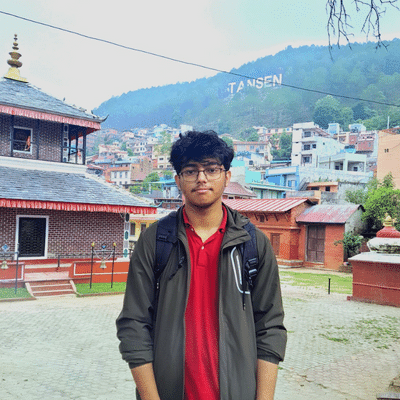
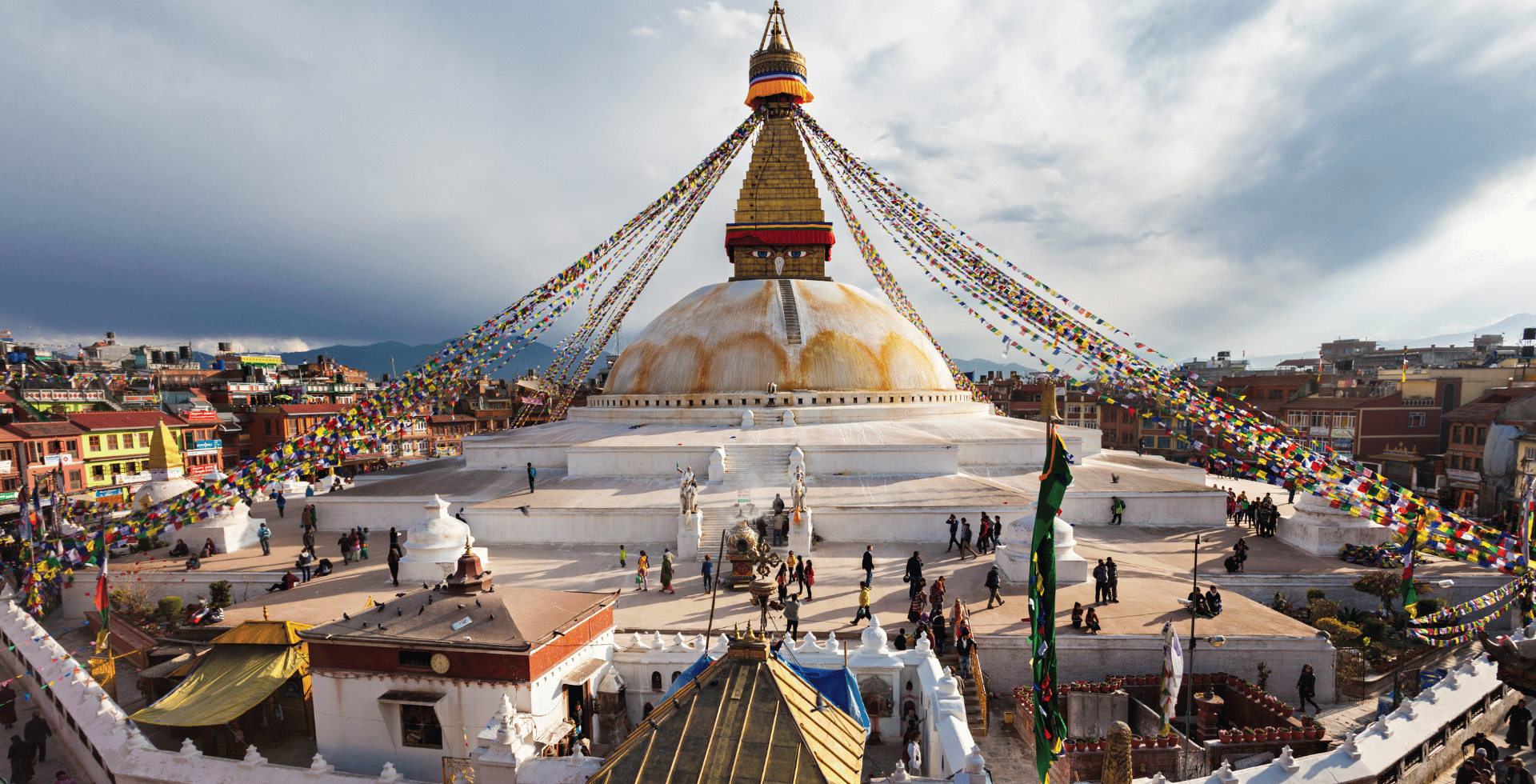
Nepal is a land of contrasts, where ancient traditions and modern life intersect and collide mesmerizingly. And in the heart of the bustling capital city of Kathmandu, there is a spiritual oasis that stands as a testament to the country's rich cultural and religious heritage. That is Boudhanath, the largest stupa in Nepal and one of the most sacred Buddhist sites in the world. Located 7km northeast of Central Kathmandu lies the massive 36-meter-high stupa that looms over the city, surrounded by a vibrant community of monasteries, shops, and prayer wheels.
Boudhanath is among the top three stupas in Nepal, alongside Swayambhunath and Namo Buddha. The stupa has different names in different cultures. In Newari, it is called Khasti Mahachaitya (Dewdrop Stupa), locals refer to it as simply Boudha or Boudhanath, and the Tibetans know it as Jarung Khashor or Lhundrup Tsek, which means the "All-Encompassing Stupa.
Boudhanath is an impressive landmark in Kathmandu, and it's hard to miss as you land at the Tribhuvan International Airport. The stupa is the focal point of Tibetan Buddhism in Nepal, with countless monasteries around it, and has been listed as a UNESCO World Heritage Site since 1979.
But Boudhanath is more than just a religious site; it is also a thriving cultural hub. Here, you can find shops selling Tibetan souvenirs and handicrafts, traditional thangka paintings, and delicious Tibetan and Nepali cuisine. Boudhanath is a treasured destination that has captivated pilgrims and travelers for ages. The area is also home to numerous Buddhist monasteries and meditation centers, where visitors can learn about Buddhist teachings and practices.
And as the sun sets over the stupa, the atmosphere becomes even more magical, with devotees lighting butter lamps and offering prayers, and the sound of chanting fills the air. Positioned at the center of a natural mandala, it exudes a potent sacred energy that has been revered for centuries.
Aside from its religious and cultural significance, Boudhanath also holds a special place in Nepal's history. During the 2015 earthquake, the stupa was damaged, but the Nepali people and all the devotees came together to restore it to its former glory. Today, the stupa stands as a symbol of resilience and hope, a tribute to the strength and spirit of the Nepali people. As you walk around the stupa and take in its majesty, you can't help but feel a sense of awe and reverence for this incredible site and the people who have worked tirelessly to protect and preserve it.
Boudhanath is also a beautiful representation of the ancient art and architecture of the Kathmandu Valley, showcasing fine and intricate details of Nepalese culture and customs. Whether you're a spiritual seeker or simply a curious traveler, Boudhanath is an experience not to be missed.
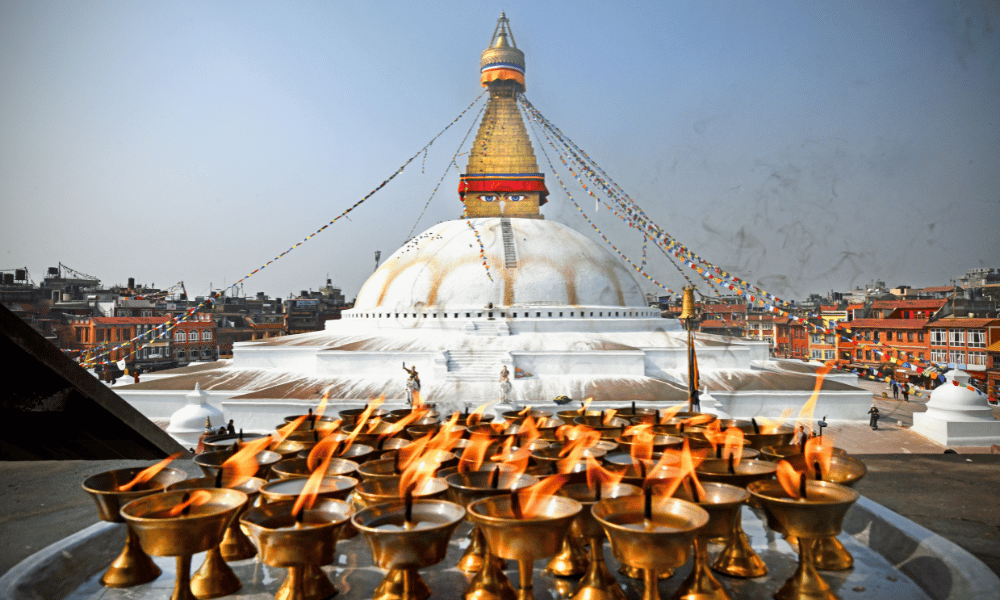
The stupa is a must-visit site for anyone looking to immerse themselves in the dynamic energy of the city and learn about the rich spiritual history of Nepal. The lively streets leading up to the stupa, with countless shops and vendors, are a treat for the senses and allow travelers to indulge in local cuisine or purchase traditional souvenirs.
Boudhanath is a place of beauty, peace, and contemplation, where you can find respite from the chaos of the city and connect with the spiritual heart of Kathmandu. Whether you're a spiritual seeker or simply a curious traveler, Boudhanath is an experience not to be missed. In this guide, we'll take you on a journey through the history, significance, and wonders of Boudhanath, and show you why this sacred site is a must-see destination for anyone visiting Kathmandu, Nepal.
|
Name |
|
|
Location |
7 km northeast of Central Kathmandu |
|
Significance |
One of the largest stupas in the world and a UNESCO World Heritage Site |
|
Size |
36 meters tall and 100 meters wide |
|
Established Date |
Believed to be constructed around 600 AD |
|
Major Festivals |
|
|
Architecture |
Influenced by Tibetan design
|
|
Nearby attractions |
|
|
Accessibility |
|
Boudhanath is a stupa with a rich and varied history. The origins of the stupa are somewhat unclear, with different sources providing differing accounts of its construction. According to some Tibetan literature, the stupa was constructed during the reign of emperor Trisong Detsen in the 8th century. However, Nepali manuscripts date the stupa back even further to the reign of King Manadeva in the 5th century, while others claim it was built during the reign of King Vrisadeva/Vikramjit in the 4th century.
One popular myth associated with Boudhanath is linked to King Vikramjit of the Licchavi kingdom. During a severe drought, astrologers advised the king that the drought would end only with the sacrifice of a man possessing Battis-Lakshanas/thirty-two virtues. The King instructed his son to go to Narayanhiti at night to find a man, who he should kill with his eyes covered to end the drought. The son, carrying out the request, later realized in horror that he had killed his father.
To redeem his act, the prince sought the advice of priests who suggested that he release a flying hen from the top of Bajrayogini, and wherever it would land, a stupa should be built on that location. The hen landed in the place where Boudhanath Stupa stands today, near the Ajima shrine which was already under construction.
That particular area was severely affected by the drought. Since locals had been collecting dew in the area to survive the drought, the site was named Khāsti, a combination of the Newari words for dew ("khas") and drops ("ti"). A fusion of which meaning Dewdrop Stupa or Khāsti. Later, during the panchayat rule in around 1960, the name of the stupa was changed from Khasti Mahachaitya to Boudha ”nath” to better reflect Hinduism.
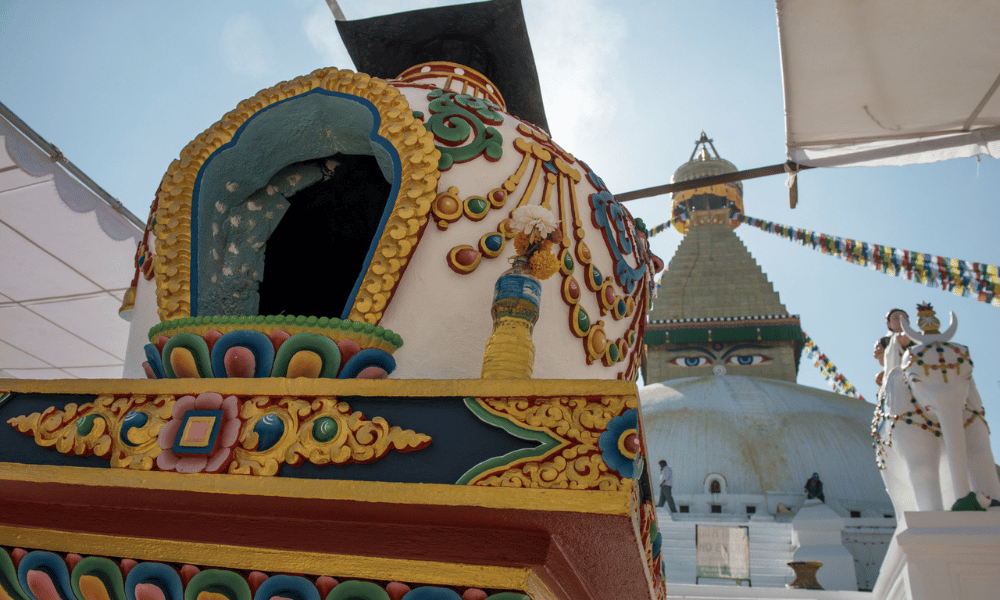
And according to Tibetan mythology, the history of the Jarungkashor stupa was released as a terma (hidden teachings of Buddhism) by Tertön Lhatsön Ngönmo and re-discovered by Ngakchang Shakya Zangpo during the renovation of the Samye monastery. Guru Rinpoche recounted the story of a Tamang woman named Samvari who aspired to build a stupa to house the relics of the Buddha Kashyapa. The king agreed the stupa to be built upon the area that could be covered with one buffalo's skin. The witty woman used long thin strips of buffalo skin to cover the circumference of where we see the stupa today.
Despite facing opposition from the local community, King Trisong Deutsen granted permission for the construction of the stupa, which came to be known as Jarung Khashor. According to legend, the name was derived from the king's response of "let it be done" (jarung) that inadvertently slipped from his tongue (kashor), as the king speaks but once.
Samvari and her four sons began building the stupa, with the help of the community, and upon completion, all the Buddhas and bodhisattvas of past, present, and future assembled and dissolved into the stupa. This extraordinary blessing turned the stupa into an object of powerful worship, and it became known as Lhundrub Tsek, “the all-encompassing stupa.
The knowledge of this stupa's history was instrumental in encouraging King Trisong Deutsen to invite Guru Rinpoche to Tibet and build Samye monastery, as described in the Pema Kathang (the biography of Guru Rinpoche). Boudhanath stupa, one of the most significant Buddhist pilgrimage sites in the world, was built following the same architectural model as the Jarung Khashor stupa and was renovated by Ngakchang Shakya Zangpo, who had also renovated the Jarung Khashor stupa and identified Lhundrup Tsek Charnel Ground during his travels to Nepal.
According to another tale, it is believed that a finger of Buddha is buried beneath the stupa, and many locals still hold this legend to be true to this day. However, verifying the authenticity of this claim is prohibited as access to the inside of the stupa is restricted.
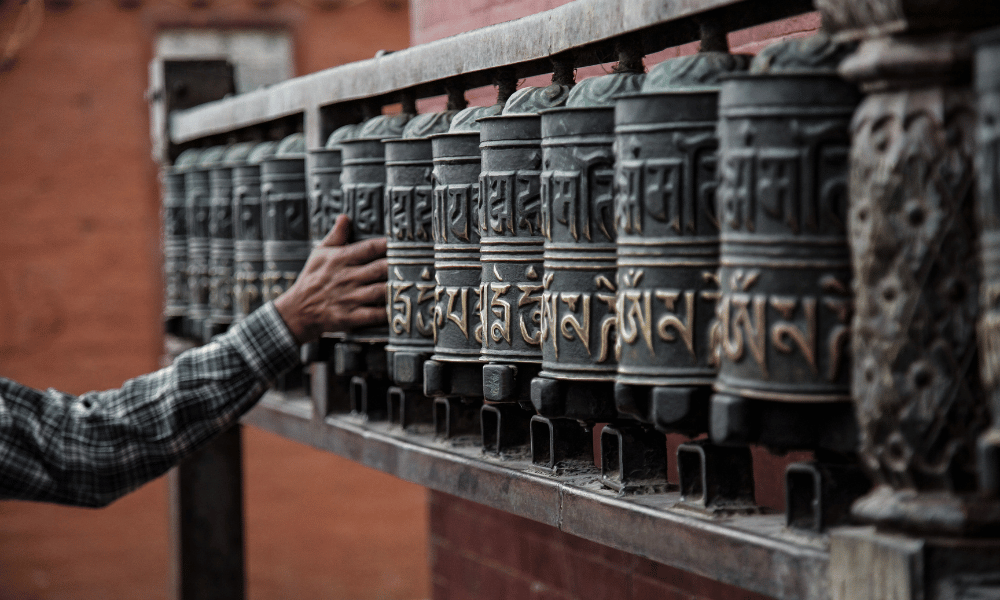
Boudhanath has stood the test of time and is now an essential religious site for Buddhists and a popular tourist attraction. The stupa has likely undergone many variations over the centuries, and the specific details of its construction and history may further date back. It remains a symbol of Nepal's rich cultural and religious history, attracting thousands of visitors each year.
The Boudhanath Stupa is definitely an awe-inspiring display of the art and architecture of Buddhist culture in Nepal. Its intricate structure and rich symbolism represent the Buddha's profound spiritual teachings and serve as a strong reminder of the interconnection of all things. Because of its beauty and significance, the stupa is an integral part of Nepal's cultural and spiritual history, as well as a source of guidance for people from all backgrounds. Below, we have discussed some of the major symbolisms observed in Bouddhanath.
Standing tall and dominating the horizon, the Boudhanath Stupa is indeed one of the largest stupas in the world and the biggest in Nepal. Its magnificent structure is a visual representation of Lord Buddha’s path to enlightenment. The Stupa is designed in the shape of a mandala, which is a sacred geometric pattern that represents the universe and the interconnectedness of all things. The mandala shape of the Boudhanath stupa is intended to symbolize the totality of existence and the journey toward enlightenment. With each part symbolizing an essential element of Buddhism, Boudhanath Stupa is undoubtedly a magnificent site of peace and serenity.
At the base of the stupa, the Earth is represented. The Kumbha or white dome represents water, while the spire represents air, and the top umbrella form symbolizes the void. According to Buddhist belief, 13 phases are needed to attain Nirvana, and the 13 spires of the stupa represent these stages. Walking clockwise around the stupa, while keeping it to your right, is customary. Prayer wheels should also be spun in a clockwise direction.
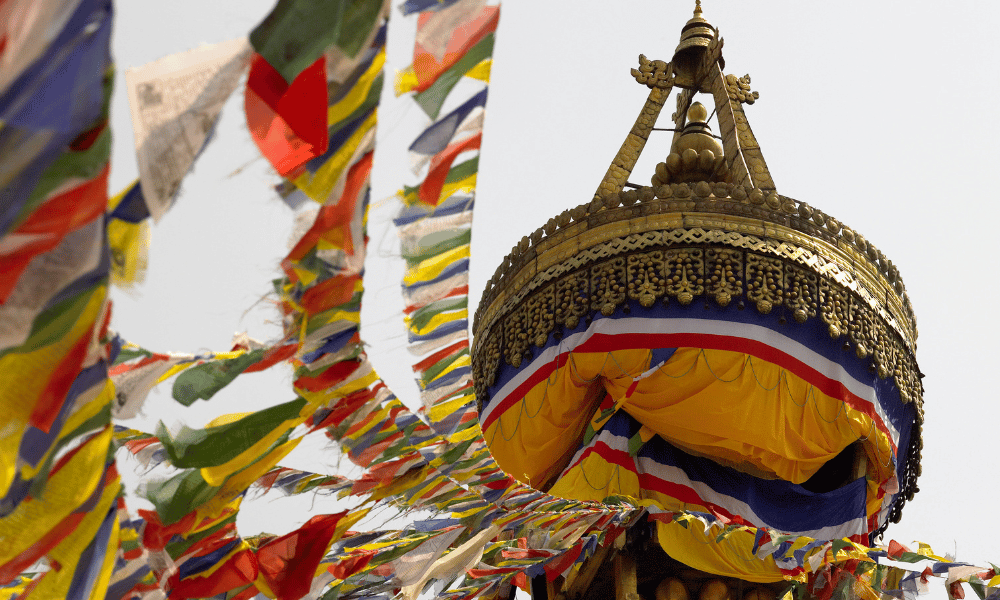
The pinnacle of the stupa is the King of Mountains, Mount Sumeru, which is believed to be the residence of the gods and the center of the world. The umbrella on top of the stupa protects three treasures: Buddha, Dharma, and Sangha. It is said that the air is represented by a gliding canopy that lies above the umbrella. The lotus, located just below the umbrella, represents self-actualization, enlightenment, and purity. The lotus flower grows in dirty water, yet emerges as a symbol of beauty without being stained. It is a symbol of wise beings like the Buddha and Bodhisattvas.
The stupa's name is derived from the thirteen steps, which symbolize the Bodhisattva's basis for enlightenment or "Bodhi" in its thirteen phases. The triangle at the top of the stupa represents fire. The four corners of the stupa’s central tower are adorned with massive pairs of eyes, which represent the Buddha's eyes of wisdom. The eyes of the stupa stand in for the Buddha's all-seeing ability. The nose of the stupa represents Nirvana and is also supposed to reflect the Nepali letter representing the number one, which stands for unity and the only path to enlightenment.
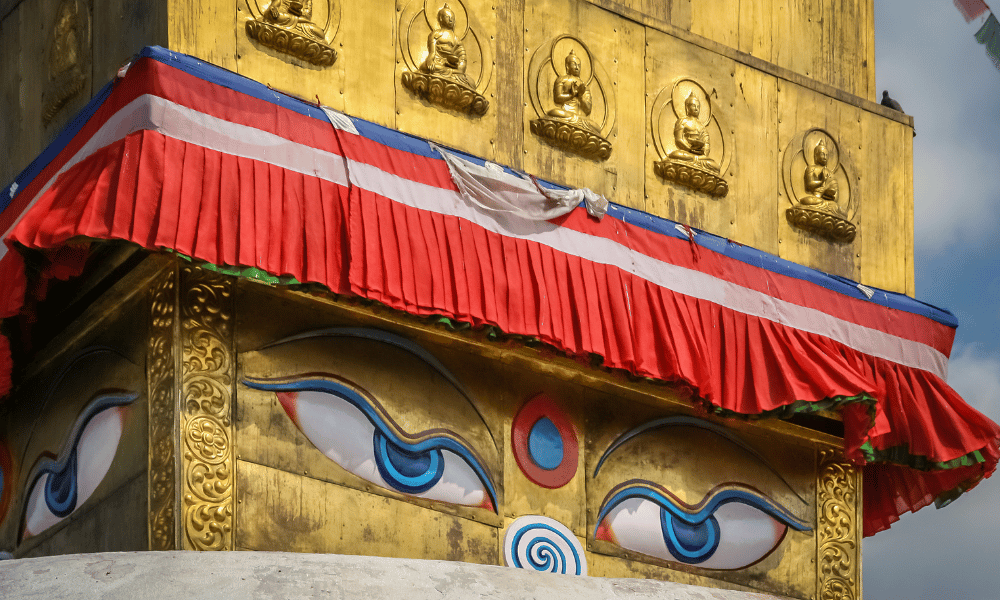
The Harmika, located above the eyes, represents the eight noble paths. The prayer flags, which are fastened to the stupas and flutter in the wind, carry mantras and prayers heavenward. The five colors on the prayer flags each have a special meaning. The color white represents innocence and the primal self, green stands for safety and protection from harm, yellow represents riches and beauty, blue represents wisdom, awakening, and enlightenment, and red stands for compassion and love.
The dome of the stupa represents the universe or the treasure Mandala container. It includes votive offerings to the gods, water of eternity, and jewels of illumination. The mandala, depicted in a square shape, represents the earthly levels. It is a physical representation of the world inside and is often used to discover the spiritual path. It frequently includes images or physical representations of the Buddha to illustrate the progression of the spiritual path. As a result, it is regarded as Lord Buddha's mansion.
Just below the dome, the stupa’s hemisphere is supported by two circular plinths that represent water. Three sizable platforms, ranging in size, make up the stupa’s base, which represents the Earth. From these platforms, you can observe the mountains while listening to the chants of the devotees doing kora or praying while they walk around the stupa. The architecture of the stupa depicts the five elements (earth, water, fire, air, and space/ether), symbolized by the five Dhyani Buddhas, who are represented in the stupa's architecture.
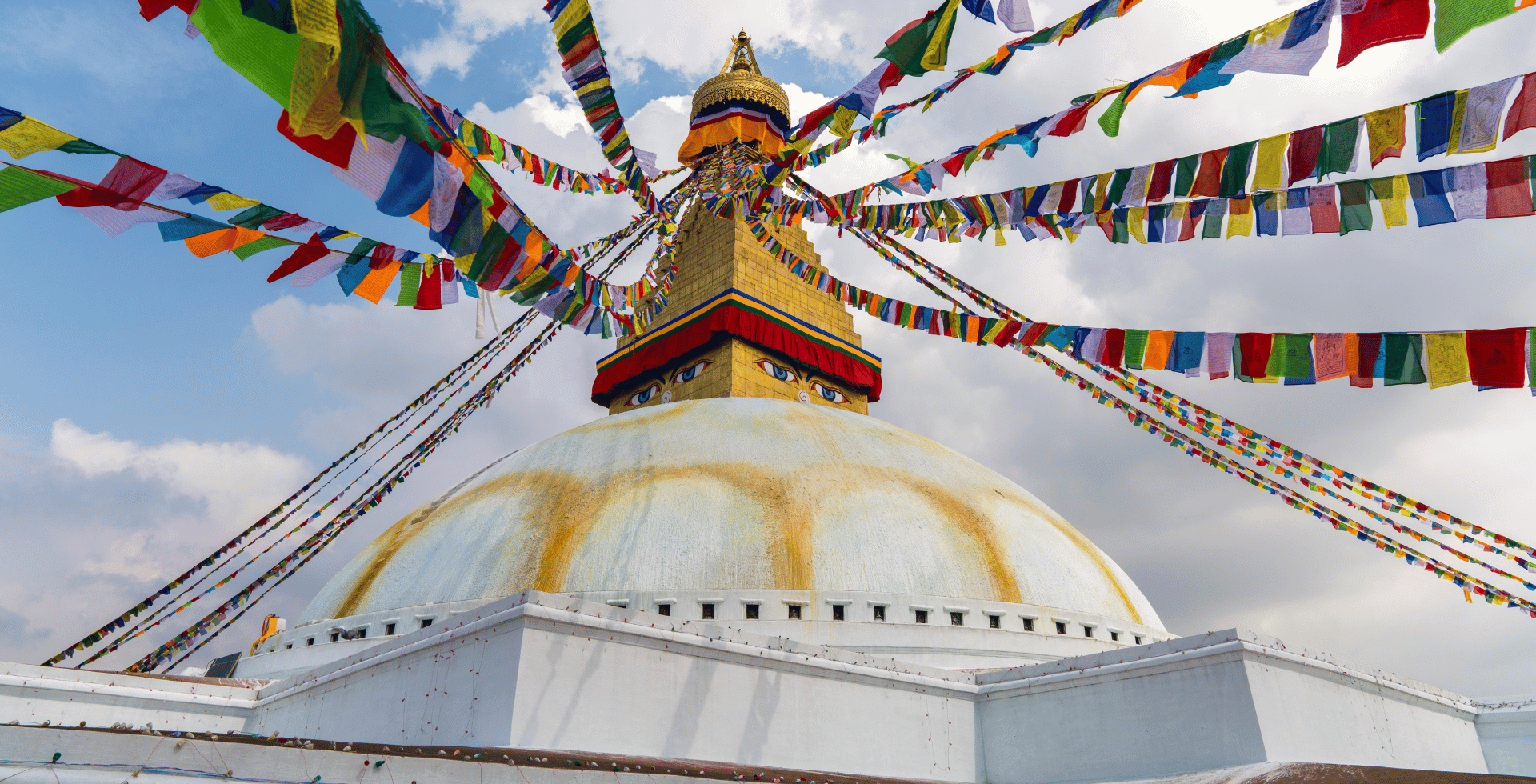
Boudhanath Stupa is a cultural and environmental beacon that attracts millions of visitors each year. The stupa's design and architecture are intended to represent Lord Buddha's journey to enlightenment and the interconnectedness of all things. The mandala shape of the stupa symbolizes the totality of existence, with each part representing an essential element of Buddhism. It is important to note the role that the Boudhanath stupa plays in the lives of the people who live in its shadow.
The stupa's cultural significance to locals and country pilgrims cannot be overstated. It serves as a center for prayer and meditation, and people from all walks of life come to visit it for spiritual purposes. Buddhists from all over the world make the pilgrimage to Boudhanath to experience the sense of calm and serenity that the stupa offers. The stupa also serves as a gathering place for festivals and celebrations throughout the year, providing an important cultural touchstone for the community.
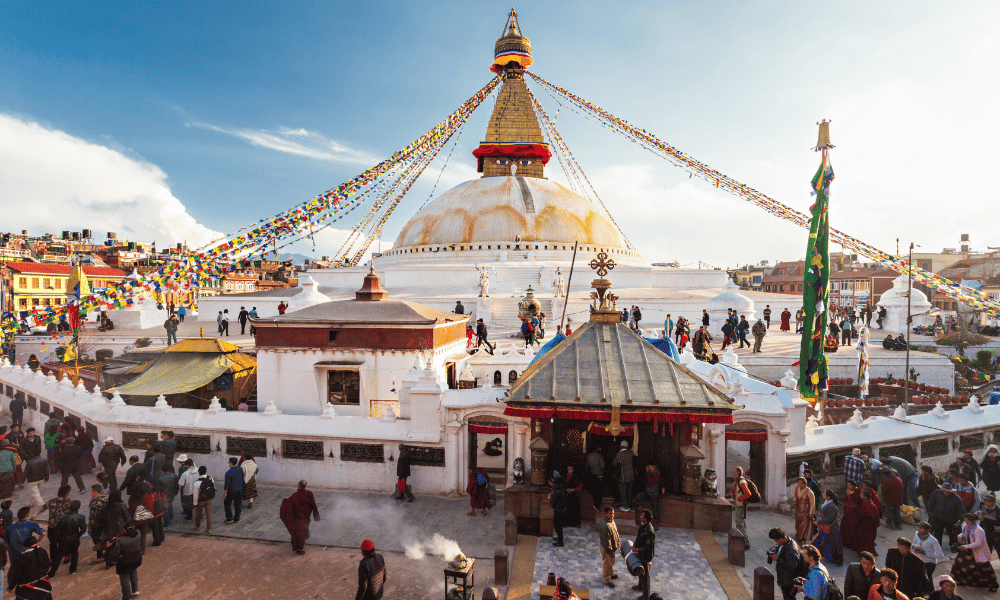
The stupa's environmental significance is equally important. The structure is a prime example of how architecture and nature can be integrated harmoniously. The stupa's design includes several elements that represent the natural world, such as the plinths that represent water and the spire that represents air. The stupa is also surrounded by a lush green space, providing a peaceful and relaxing environment for visitors.
The stupa's popularity with tourists has grown over the years, with many visitors coming to experience the spiritual and cultural significance of the site. The stupa's unique architecture and design make it a remarkable landmark, while its historical and religious significance make it a must-see destination for travelers from around the world. Visitors to Boudhanath can join in on the daily prayers and rituals or take part in traditional crafts and cultural activities offered by the surrounding businesses.
In addition to its cultural and environmental significance, the Boudhanath Stupa is also an important economic hub. The site attracts millions of visitors each year, which in turn creates opportunities for local businesses and entrepreneurs. Visitors can enjoy a variety of local and international cuisine, as well as shop for handicrafts and souvenirs at the many stores and markets surrounding the stupa.
In conclusion, the Boudhanath Stupa is a cultural and environmental icon that holds significant importance to the local community, as well as to Buddhists from around the world. The stupa's design and architecture offer a unique representation of Lord Buddha's journey to enlightenment, while its natural surroundings provide a peaceful environment for spiritual reflection. The stupa's importance to the local economy and the tourism industry cannot be understated. As a result, it is a must-see destination for travelers looking to experience the beauty and richness of Nepal's cultural heritage.
The Boudhanath Stupa's impressive size and intricate design reflect the depth and richness of Buddhist teachings. Each element of the stupa's structure holds symbolic significance, representing the elements of nature, the path to enlightenment, and the treasures of Buddhism. It serves as a focal point for Buddhist practitioners who perform kora, prayers, and circumambulations around the stupa. The stupa's design and symbolism remind us of the Buddha's teachings and the path to enlightenment, and its impressive size and grandeur evoke a sense of wonder and reverence in all who visit it.
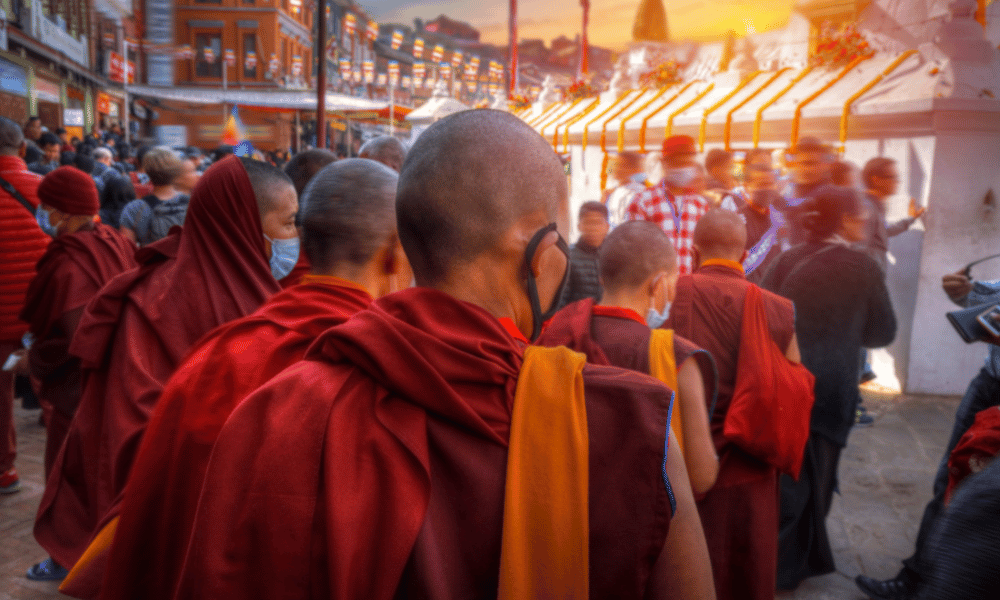
To reach Boudhanath, you can take a taxi from a taxi stand and ask to be dropped off at the main gates. Alternatively, you can use ride-sharing apps like Pathao or InDriver based in Kathmandu, which can help you avoid traffic and provide transparent pricing.
You can also take a local bus from anywhere in the ring road and listen for conductors shouting "Boudha-Boudha." Alternatively, you can get off at Chabahil and take a 15-minute walk through bustling streets to reach the stupa. Biking to the stupa is another way you might fancy. See what suits you the most and have a great day.
There are numerous interesting things to explore and experience in the vicinity of Boudhanath Stupa. Visitors can stroll through the bustling market area, relish delicious food at the cafes and restaurants, and observe the daily life of the Nepalese people. With some luck, tourists can witness a sacred prayer ceremony conducted by Newari priests for world peace at the base of the stupa.
The area around Boudhanath Stupa is a fascinating world in itself that showcases the resilience and adaptability of the local Nepali people in the aftermath of the earthquakes. In addition to the stupa itself, visitors can explore several Gumba and monasteries, including Samteling Monastery, Jhamchen Lhakhang, and monasteries founded by the indigenous Tamang and Chiniya Lama. These monasteries carry out various traditional and ceremonial activities throughout the year, such as festivals like Loshar, Ropai Jatra, and Buddha Jayanti.
Tourists can also visit over twenty monasteries (Gompas) surrounding Boudhanath. While Tamang Gompa is the most famous and popular, smaller monasteries like the old and new Dazang monasteries can offer a more peaceful experience. However, it is essential to remember that these monasteries are not tourist attractions and are often closed. Visitors should be respectful and mindful of the cultural significance of the place.
Additionally, visitors can explore the heritage walk to the northeast of the stupa, which leads to the famous and privately owned Taragaon museum. The museum has displays representing Nepal's cultural history and modern lifestyles. The Boudhanath Stupa area is a fascinating place to visit and can easily take up an entire day, especially when visiting the surrounding monasteries.
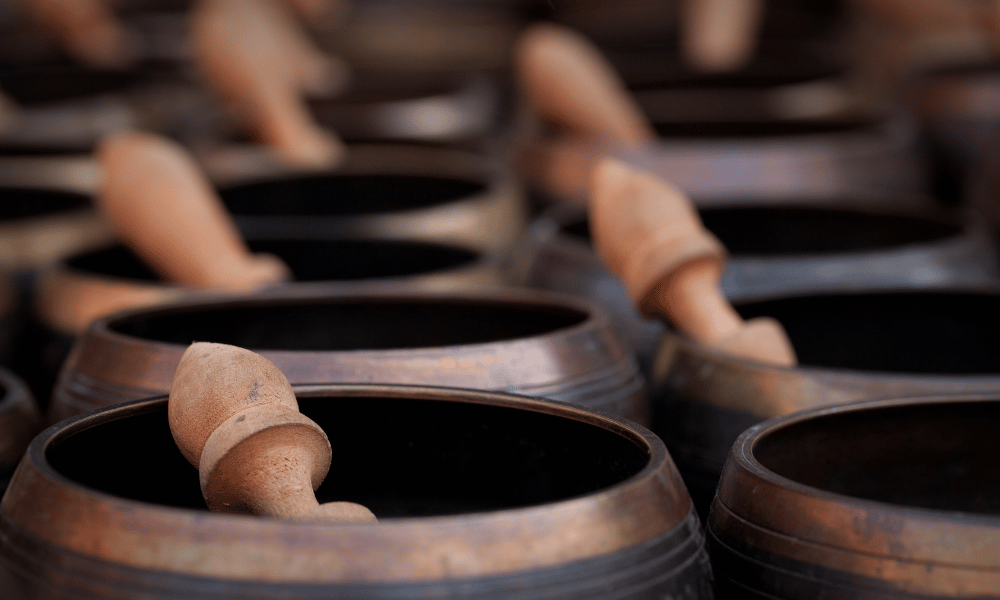
Finally, many souvenir shops are selling Tibetan singing bowls, jewelry, brass work, and incense in the vicinity of Boudhanath. Prayer flags and Thangka paintings are also available. Visitors should know the prices before bargaining to avoid being overcharged.
Overall, Boudhanath Stupa and its surrounding area offer a rich cultural experience that is well worth a visit. Visitors can participate in various religious ceremonies, explore the ancient monasteries, and witness the daily life of the Nepalese people.
The entrance fee for foreign nationals in Boudhanath Stupa is 400 NPR, for residents of SAARC country is NPR 100, and is free for Nepalese people and children below 10 years of age.
You can find ticket offices on the major streets that lead into the stupa square, and if you're staying at a local guesthouse, you only need to pay once. If you want to just take a stroll around, note that the ticket offices close in the evening but the stupa square remains open 24/7.
|
Foreign Nationals |
NPR 400 |
|
Saarc Residents |
NPR 100 |
|
Local Nepalese and children below 10 |
Free |
There is no definitive time to visit the stupa as each time of day offers a unique and memorable experience. During the day, visitors can enjoy the vibrant atmosphere and the lively, yet dynamic company of many others. In contrast, the evening offers a peaceful and serene ambiance, allowing visitors to fully immerse themselves in the tranquil atmosphere of the stupa. Here are some tips that you can use to get the best out of your time.
Boudhanath Stupa is a sacred site for both Buddhists and Hindus, and visitors should respect the local customs and dress appropriately. Avoid littering and be sure to not cause any disturbances for those worshipping in the premise.
Walking around the stupa is called Kora and is a great way to experience the local culture and atmosphere. You can also turn the prayer wheels while doing so. It is customary to walk around the stupa in a clockwise direction, keeping it to your right side, and to spin prayer wheels in the same direction. When circling the stupa, be sure to complete it an odd number of times as per tradition.
There are over twenty monasteries around Boudhanath, and each offers a unique insight into Tibetan Buddhism. Make sure to visit some of the monasteries, including Shechen, Fulhari, Nunarry, and Sherpa monasteries. Boudhanath has a rich history, and there are many museums and cultural centers that showcase the local history and art.
Boudhanath is home to some of the best Tibetan and Nepali cuisines and is considered a food heaven. Make sure to try momos, thukpa, the famous Tibetan butter tea, and a little bit of every flavor. Likewise, The shops around Boudhanath are known for their unique souvenirs, including Tibetan singing bowls, jewelry, brasswork, incense, prayer flags, and Thangka paintings.
Small vendors might not accept cards or online transactions, so carrying some cash on hand is wiser. Along with it, the festival is crowded and a lot of times dusty so it might not be a great place to be without a mask. Boudhanath is a photographer's paradise, with stunning architecture, colorful prayer flags, and bustling streets. Take a photography tour to capture the beauty of this place.
Boudhanath celebrates many festivals throughout the year, including Mamla Jatra, Chechyu Puja, Loshar, Temal Jatra, Ropai Jatra, and the major festival to be celebrated there, Buddha Jayanti, on the auspicious day believed to be Siddhartha Gautama’s birth date. Plan your visit accordingly to experience these colorful festivals.
Since Pashupatinath temple is only a 30-minute walk away from the stupa, you can easily visit both on the same day making the most out of your visit and enjoying the contrast between these two heritages.
Boudhanath Stupa is one of the largest stupas in the world and a UNESCO World Heritage site. It is significant as a pilgrimage site for Tibetan Buddhists and a cultural landmark in Kathmandu.
Visitors can walk around the stupa, spin prayer wheels, and visit surrounding monasteries and museums. There are also many shops and restaurants in the area.
Yes, photography is allowed in most areas, but it's important to be respectful and not disturb ongoing religious ceremonies.
Boudhanath is located in the northern part of Kathmandu and can be reached by taxi, bus, or on foot. It's about a 30-minute drive from the city center.
The best time to visit is early morning or late afternoon when the stupa is less crowded and the light is better for photography.
The origins of the Boudhanath stupa are not clear. Tibetan literature says the stupa was built in the 8th century by Emperor Trisong Detsen. Nepali manuscripts suggest it dates back to King Manadeva in the 5th century, while some claim it was built during the reign of King Vrisadeva/Vikramjit in the 4th century.
The entrance fee for foreign nationals in Boudhanath Stupa is 400 NPR, for residents of SAARC country is NPR 100, and is free for Nepalese people and children below 10 years of age.